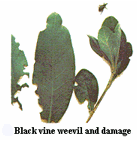Otiorhynchus sulcatus (F.)
The black vine weevil, also known as the taxus weevil, has become a serious pest in nurseries across the northern United States since its introduction from Europe approximately 150 years ago. It has a wide range of host plants including taxus (yew), rhododendron, hemlock, azalea, euonymus, cyclamen, laurel, gardenia, juniper, impatiens, boxwood, holly, grape, strawberry and various other woody and herbaceous plants.
Black vine weevils overwinter in the soil as larvae or as adults in plant debris, buildings or other sheltered areas. They have one generation per year (more if in a greenhouse). Adult weevils are flightless female beetles that disperse only by crawling. Males are not known to occur, and females produce eggs without mating. The 5/8-inch weevils are black with gold flecking on the wing covers (elytra).
Adult weevils feed at night on the foliage of host plants causing U- or C-shaped notching injuries along the margins of leaves and needles. Leaf notching is much less serious than the injury caused by the immature weevils (larvae) feeding on the roots. Adults hide during the day in leaf litter, other debris, or soil under the plants.
Adult weevils are more abundant after wet summers and may commonly be found in and around houses, being attracted to lights. They do not cause a household problem indoors other than their presence.
Females deposit eggs in the soil at the base of host plants. Larvae hatch in approximately ten days. The larvae are legless, slightly C-shaped white grubs with brown heads. Larvae feed on the roots of host plants and in heavy infestations may destroy most of the small feeder roots. Larger roots and the crown may be girdled (removal of the bark in a ring) resulting in wilting, yellowing of the foliage, and possible death of the plant.
 Plants should be examined very carefully before purchase to detect notching of the leaves. Plants showing signs of adult feeding should not be purchased because larvae may be in the soil of the root ball. Many infestations of black vine weevil occur as a result of purchasing infested plants. If controls are needed, they can be directed at the adults to kill them before they lay eggs. Larvae are usually found deep in the root ball, and a soil-applied insecticide may be needed for effective control.
Plants should be examined very carefully before purchase to detect notching of the leaves. Plants showing signs of adult feeding should not be purchased because larvae may be in the soil of the root ball. Many infestations of black vine weevil occur as a result of purchasing infested plants. If controls are needed, they can be directed at the adults to kill them before they lay eggs. Larvae are usually found deep in the root ball, and a soil-applied insecticide may be needed for effective control.
Research has determined that adults emerge from the soil from late May to early June but do not begin to lay eggs until three to four weeks after emergence. Therefore, if insecticide treatments for adults are used they should be applied beginning in mid- to late-June.
Black vine weevil adults can be monitored using burlap traps. A piece of burlap (approximately four feet by three feet) is bunched lengthwise to create folds and then is wrapped around the base of a host plant. Adult weevils will crawl into the folds of the cloth to hide during the day. The traps can be inspected by gently removing the burlap and examining it for weevils.
If black vine weevil adults are present or feeding injury is observed, a recommended insecticide can be applied thoroughly to the plant or soil and a surrounding two-foot radius of soil within three to four weeks after first detection. If weevils are found only in certain areas of a field or nursery, growers should consider applying spot treatments if using insecticides. This would consist of spraying only the infested areas and a narrow buffer zone of uninfested plants. Burlap traps placed both inside and outside the treated areas can be used to help determine if the treatment provided adequate control. Chemical treatments may need to be repeated as necessary, following all label directions.
Please contact your local Cooperative Extension Center for chemical and other management options or visit the on-line guides of Cornell University and Penn State. Note: This information may not apply to your state or other geographical area.
Updated by Donna Ellis, Senior Extension Educator, UConn IPM Program, 2011.
Prepared by: Richard Packauskas. Entomologist, and Roger G. Adams, Integrated Pest Management Program Leader. June 1990.
The information in this document is for educational purposes only. The recommendations contained are based on the best available knowledge at the time of publication. Any reference to commercial products, trade or brand names is for information only, and no endorsement or approval is intended. The Cooperative Extension System does not guarantee or warrant the standard of any product referenced or imply approval of the product to the exclusion of others which also may be available. The University of Connecticut, Cooperative Extension System, College of Agriculture and Natural Resources is an equal opportunity program provider and employer.